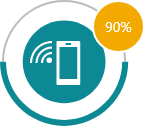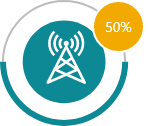BACKGROUND
Nigeria is among the 30 high burden countries for TB.[1, 2] [1] , [2] In 2020, the estimated incidence of TB in Nigeria was 452,000 TB cases; out of which, 138,591 were diagnosed and notified [1] This gap in TB case identification is a major area of focus for the national TB program.
With over 34,000 of all people with TB also infected with HIV and 2061 MDR/RR TB confirmed cases, Nigeria is included in the list for the top 30 TB/HIV as well as DR-TB high burden countries too.
Among the notified cases, 36% were women, 57% were men, and 7% were children. [1] Though the case detection for TB is low in Nigeria, this is one of the few countries which have shown an increase in overall TB notification in 2020, against 2019.
Nigeria has taken some significant steps towards meeting the End TB Targets and is aiming at reducing the TB prevalence rate by 50 percent and TB mortality by 75 percent by 2025 . [5] In 2020, NTP conducted an end-term assessment to evaluate the current NSP to inform and prioritize the innovations and activities for National Strategic Plan for TB (NSP 2021-2025). The revised NSP (2021-2025) highlights the importance of strengthening the information management systems for the provision of TB care. [6]
With technical support and resources from USAID and Global Fund, the Management Science for Health (MSH) in Nigeria has invested in eTB manager Case Based TB notification system to capture real-time TB data, which is extracted and imported to the national DHIS2 portal. [6]
Currently, e-TB Manager is deployed nation-wide, and data is entered by all 774 local government supervisors, more than 300 high-burden TB facilities, 16 DR-TB treatment centers, and 37 TB program managers. [7] To feed data to the national HMIS (DHIS2), eTB manager has mechanisms for data integration which enable comprehensive data review and analysis of TB data nationally.
Under the revised NSP (2021-2025) and with continued government commitment, eTB manager platform is undergoing an assessment to improve and standardize its data indicators, integration with laboratory network and engaging all care providers. [6] Enhancement are underway to the e-tb mobile version to allow for an offline version that will ensure continuous data entry without internet connectivity, thereby allowing health units to notify and follow-up with presumptive clients and cases even when internet connectivity is lacking.
In Nigeria, TB prevalence survey found that approximately 29% of cases were being treated in the private sector. Therefore, engagement of private providers is critical. In July 2020, the National Tuberculosis and Leprosy Control Program (NTBLCP) along with, the Institute of Human Virology Nigeria (IHVN) launched a mobile application the Mobile Application for Tuberculosis Screening (MATS) for screening and notifying tuberculosis (TB) cases by private health care providers in order to ensure treatment of more cases in the country. Use of MATS has shown significant progress in increase in the TB screening efficiency and linkage between the facility and community-based units. [4]
Information and communication technology (ICT) promote social, economic and political accountability and improves the delivery of basic health services, Internet user penetration in Nigeria is at 51 percent. As of July 2021, there were more than 108 million internet users in Nigeria. It has roughly 170 million mobile phone users based on subscriptions. However, only 10 to 20 percent of the population uses smartphones while the rest rely on more traditional mobile phones, thus limiting their options to voice calls and text messages. [8] Enhancing digital inclusion in Nigeria is essential, given that access to reliable and affordable connectivity is a foundational step in maximizing the impact of deploying digital technologies on the government’s development aspirations.
This country digital assessment report is prepared based on the discussions held with the NTP Nigeria and its partners. The report aims at providing strategic recommendations and way forward to country leadership in developing and scaling a comprehensive case-based TB surveillance system while leveraging the existing infrastructure, in-house capacity and assets. Detailed recommendations are provided in the later section of this country report.

STATUS OF CASE BASED TB NOTIFICATION
Nigeria uses two platforms to support their routine TB notification and surveillance:
eTB Manager: It has been deployed nation-wide, with data coming from more than 300 high burden TB facilities and data entry by all 774 local government supervisors. It was initially introduced in 2011 for DR-TB case reporting and was expanded to DS-TB reporting in 2016.
The remaining low burden centres with no access to the platform are reporting case based data via paper forms to district facilities where data entry is done by the Local Government TB supervisor in the eTB manager system.
The current version of eTB manager is used for both DR-TB and DS-TB notification, monitoring and treatment outcome.
DHIS2: The national HMIS of Nigeria has data sets that capture TB data from across the country. Data is extracted from eTB manager and imported on this platform.
The current system generates quarterly reports which are being used by district, state and national program managers.
The NTP is committed to build a comprehensive TB surveillance mechanisms and systems for the country. Under NSP (2021-2025) NTP has plans for system integrations to support the building of this holistic system.
System integrations with laboratory management systems, standardizing the templates and improving all aspects of TB prevention and services are priority for the NTP.
MATS app is a case-based notification system for all private providers (For profit Private providers, Faith based Organisations, and any other private player notifying for TB).
The private sector in Nigeria contributed 14% to the total national TB case notification in 2019, and with the improved PPM engagement strategy, the contribution has increased to 26% in 2020. Continuous effort is fostered and has led to increased number of engaged PPM facilities to use the MATS app. The application is already rolled out in 21 out of 37 states and there is a plan to integrate data from MATS app with eTB manager and GxAlerts systems.
Upgrade and deployment of the application are implemented by IHVN under the Public-Private Mix (PPM) grant funded by the Global Fund to Fight AIDS, Tuberculosis and Malaria.

ELECTRONIC TB NOTIFICATION DATA COLLECTION AND USE
| TARGET | CURRENT SCALE | COLLECTION TOOLS | DATA TYPE | DATA USAGE | |||
|---|---|---|---|---|---|---|---|

National Level
|
Data Not Collected from this level
|
Excel Pivot eTB manager Dashboard | |||||

State
level
|
36+ Federal Capital Territory (Abuja) | Data Not Collected from this level | Excel Pivot eTB manager Dashboard | ||||

District Level
|
774 | 774 | eTB Manager
(Data received
from Low burden
Facilities) DHIS2 |
Case Based
Aggregate |
Excel Pivot
eTB manager
Dashboard
DHIS2 dashboard |
||

Facility level
|
17699 | ~ 9000
(Low Burden) 370 (High Burden) |
Paper based /eTB
manager Web app
eTB manager Web/mobile version |
Case Based |
Excel Pivot
eTB manager Dashboard |
||

Community Level
|
Data not collected from this level | ||||||

CASCADE OF CARE MONITORING
PRESUMPTIVE SCREENING
TB Testing
Treatment Initiation
Treatment Monitoring
Treatment Outcome
Contact Tracing






| KEY DATA VARIABLES | Yes/No |
|---|---|
| Demographic details (Age, DOB, Gender) |

|
| Address and contact details (Country, Division, District, House address) |

|
| Geolocation (GPS coordinates of the household) | |
| Contact details (Phone number/Mobile number, WhatsApp, Email etc.) |

|
| Health Facility address |

|
| Type of health facility (Public, Private etc.) |

|
| Site of TB (Pulmonary, Extra-pulmonary) |

|
| Type of diagnostic test (Microscopy, GeneXpert, TruNaat, CXR, etc.) |

|
| Date of test result |

|
| Drug susceptibility (DSTB, DRTB) |

|
| Treatment Regimen |

|
| Treatment start and end date |

|
| Co-morbidity (HIV, Diabetes, COVID-19 etc.) |

|
| Treatment monitoring/adherence |

|
| Treatment outcomes |

|
| KEY INDICATORS | Yes/No |
|---|---|
| Presumptive screening (proportion) | |
| Treatment initiation (proportion) |

|
| Treatment monitoring/adherence |

|
| Treatment outcome (proportion) |

|
| Spatial distribution of TB notification | |
| Age-group & sex wise aggregate numbers and proportions notified |

|
| Basis of diagnosis wise aggregate numbers and proportions notified |

|
| Type/site/drug resistance wise aggregate numbers and proportions notified |

|
| Provider source-wise aggregate numbers and proportions notified |

|
| Comorbidity wise aggregate numbers and proportions notified |

|
| Key-population wise aggregate numbers and proportions notified |

|
| Estimate/Target wise notification/treatment coverage (proportions) |

|
| Provider-type disaggregated treatment outcomes (proportions) | |
| Comorbidity disaggregated treatment outcomes (proportions) |

|
| Key population disaggregated treatment outcomes (proportions) |

|
 Digital
(aggregated)
Digital
(aggregated)
STATUS OF ELECTRONIC CASE BASED TB SURVEILLANCE
Electronic System For Case Based TB Notification
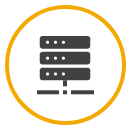
eTB manager is the national TB case notification system.
Lowest Unit For TB Notification Digitisation
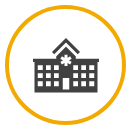
High Burden Facilities, District level (Low Burden Facilities)
Stage Of Notification

Registration for presumptive
Level Of Access And Use Of TB Notification Data
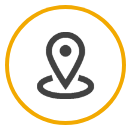
Facility level
Private Sector Notification

MATS App is used for private sector- this is being integrated with e-TB Manager and GXAlert
Frequency of digitization of TB notification

High burden facilities - Real
Time
Low burden facilities -
Ranges from real time to
Quarterly
Mode Of Follow-Up With Notified Cases
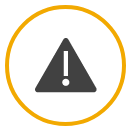
Flagging module helps in identifying gaps that promotes the facility users to call or physical visit for follow up
Scale Of Implementation
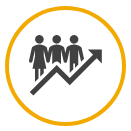
National Roll-out
Contact Tracing For TB Notified Cases
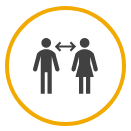
Paper based
Multi-Channel Enablement

eTB mobile app and web application
Govt. order for mandatory TB notification

Mandatory case notification Govt. notice was passed in 2017
PRIVATE SECTOR NOTIFICATION

The private sector contribution for notification all types of TB cases is 26%. Country has acknowledged the importance and contribution of private sector in improving TB. In 2020, MATS application was launched to ensure real time TB notification by private providers players.
COUNTRY IT CAPACITY
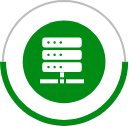
Country Server
In country hosting outsourced to 3rd Party agency
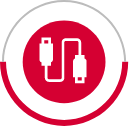
Interoperability
Necessary APIs available, Data export available but to be integrated
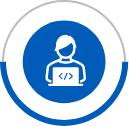
Country IT team
NTP employs an in-house IT team that provides technical support
CURRENT RESOURCES AVAILABLE
USD 0.6 Million is current available resource with the country to continue its national level scale up of e-TB manager to the lowest reporting Unit.
USD 0.4 million fund is available for purchase of Hardware (Mobile phones, Desktops). This is supported by Global Fund.
Country has proposed an e-learning module to be developed for its resources under C19RM.

MILESTONES ACHIEVED AND ROAD MAP
2011
Introduction of e-TB manager for DR-TB cases
2016-17
eTB manager upgraded to integrate DS-TB module and districts training for national level scale up
2018
eTB Mobile app synchronized with online version of eTB
2017
eTB manager scale up to 218 sites and integration with DHIS2
2019
MATS app for private sector developed
2021
NTP undertook national assessment of the current TB notification system to identify gaps in the systems and work on building a more robust system
2022
Upgrade the dashboard by integrating the data from GX alerts, eTB manager making it comprehensive for facilities, state, and national level use so that they can do the analysis real time and take necessary actions.

OTHER COMPLEMENTING DIGITAL TOOLS
| Purpose | Tools | Channel | Developed By | Supported By | Scale |
|---|---|---|---|---|---|
| Digital Adherence | 99DOTS
Video DOTS |
SMS based adherence system | Everwell | KNCV- Stop TB Partnership | Pilot |
| Logistic Management System | LMIS- National health management information system | Web Application | Chemonics | USAID | National |
| Laboratory Information Management | GxAlert(Aspect) | Web Application | SystemOne/ASPECT | The Global Fund | National |
| CAD4TB | Web Application | DELFT | KNCV- USAID | Pilot | |
| 21DCXR with CAD4TB | Web Application | DELFT | The Global Fund | Pilot | |
| Community Led Monitoring (for contact tracing) | EWORS | Web Application | EWORS | KNCV- USAID | Pilot |
| Contact Tracing | Comm care contact tracing module | Web Application | Dimagi | KNVC | Yet to be implemented |

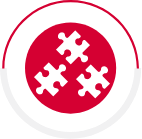

KEY CHALLENGES

Limited IT Capacity : The in-house IT Team’s capacity is limited. The NTP does not own the source code for the platform. Therefore, NTP relies on 3 rd party developer for system upgrades. This is time consuming and causes delays in system enhancements and in fixing bugs.

Hardware limitations (Power Supply internet connectivity, server capacity, availability of device for data entry): Infrastructure issues in rural and remote areas delays data entry into the system, resulting in backlogs.

Backlog clearing is one of the main challenges of the system due to high volume data (as high as 200 records per day) and long notification forms (multiple data variables entry). The system does not allow partial data saving and entry to mitigate the backlogs.

Technical and user experience challenges combined with lack of digital skills with the staff at the facility level further hampers data entry into the system.

Real time data availability: With a good proportion of data being entered offline and the differences in frequency of data reporting, developing and getting access to a real-time data dashboard for timely actions becomes difficult.

Inadeuate data analysis: despite publicly available e-TB manger dashboard in the programme website, data analysis is inadequate and limited.
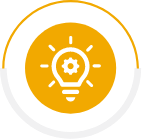
NTP VISION
- ❖ To build a robust and comprehensive system that has streamlined the data variables to be captured for a case to ease out the workload, decreasing the backlog, and promoting real-time data entry.
- ❖ Templatizing the entry of case-based data in stages
- ❖ Adding modules on contact tracing and case management in the system
- ❖ Integration of the GXalert within the workflow of the eTB manager system.
- ❖ Upgrade the DHIS2 dashboard by integrating the data from GX alerts, eTB manager and MATS app making it comprehensive for Facilities, Districts, State, and National level use so that they can do the analysis in real time and take necessary actions.
- ❖ Fill in for the training gaps by building digital capacity among its staff and supplying adequate hardware and software.

RESOURCES NEED
Based on multi-stakeholder discussions, country feedbacks and recommendations for full-filling country’s vision, we have put together an estimated investment requirements and areas needing support for provisioning of a comprehensive case based digital TB surveillance system
Hardware and Infrastructure :

Mobile Devices (for data collection):Nigeria has 17,699 facilities and the system is expanding to additional 5000 facilities in 2022. To provision mobile device for every facility for case-based TB surveillance, USD 3,404,850 will be needed assuming USD 150 per mobile devices.

Tablet (for data use): Nigeria has 774 districts and 37 states (Abuja as federal state) and to promote active data use, each district and region should be given a tablet which would cost roughly around USD 162,200 assuming USD 200 per Tablet devices.

Internet: In case WiFi is not available in each facility, then mobile internet cost of around USD 7,053,000 should be considered (assuming USD 100 mobile data cost for the entire year per facility, district and regional user).

Server: : Based on the current volumes of new cases, Nigeria would need an investment of USD 30,000-40,000 for next 3 years for server and server maintenance.
Note: Existing devices available through other health programs can be leveraged. In that case, the above-mentioned costing can be accordingly considered.
Software Development :

Based on various multi-stakeholder meetings and given the fact Nigeria already have a strong foundation for e-TB Manager system for TB, around USD 250,000-400,000 should be budgeted for a comprehensive TB surveillance system and analytical dashboard for data use.
Capacity Building and Implementation :

After the software development, a dedicated pool of technical resources will be needed to support platform administration, data management and support. A team of 4- 6 skilled resources attributing to a cost of around USD 48,000-72,000 per annum should be budgeted (or USD 144,000-216,000 for 3 years assuming USD 1,000 per month per resources). Additionally, reskilling of the current IT team should be budgeted.

Training: This would involve training material development and onsite and remote training of the trainers. Training sessions should be planned for each of the 774 districts, which could cost roughly USD 100 per district, amounting to USD 77,400, which will be further supported with e-Learning packages. Also, a dedicated trainer should be budgeted in case there is none.
TOTAL investment of around USD 10.5 – 11.5 million for 3 years will be needed on developing a comprehensive case-based digital TB surveillance system for Nigeria.
Disclaimer: The above budget is a function of number of facilities, districts and regions and expected volume of data. This only provides a ballpark figure of what is needed in terms of budget.

Data is light, and the Nigeria TB Programme is poised towards having a robust electronic data management and reporting system for an effective and efficient evaluation of our interventions as well as for resource mobilization


Nigeria

Dr. CHUKWUMA ANYAIKE |NTP Manager

Recommendations
Following are some of the key recommendations suggested based on the findings of this assessment of country’s digital ecosystem and infrastructure:

Strategic Costing Plan
As a first step it is important for the country to create a comprehensive costed action plan for development, implementation and scale up of the TB case based surveillance system.
Based on NTP’s vision and the recommendations for improvements, the plan should clearly define targets with actionable interventions and funding requirements supported with a detailed work plan along with timelines. The plan will help the country to assess and monitor the progress to ensure that any risks can be duly mitigated.
Tentative timeline: Month 0-1

Expansion of TB surveillance
system
The NSP (2021-2025) clearly highlights the importance of strengthening the TB Notification information system for improving all the TB service provisions. [6]
Nigeria has already developed and deployed the Case based TB notification eTB manager which is used as the real time digital surveillance system in its 370 high burden TB sites. The rest of the low burden sites are also covered with near real time implementation. At the same time, DHIS2 is already functional across the country. The presence of these systems lay a strong foundation for executing the vision of creating a comprehensive and integrated real-time case-based TB surveillance and notification system.
It is recommended that the current eTB manager/DHIS2 infrastructure needs to be scaled up to cover the whole country. The system needs to support integration with external systems like Gen Xperts, Tru-Nat, Digital X-Ray outputs, current National Health management systems and MATS app as visioned by the national TB program with the concept of an integrated Health Information Management System (HMIS).
These data exchanges can be made seamless with API sharing between the platforms and the central repository. [6]
Recommended data exchange/ ETL tools like Talend, Informatica [10.1] , [10.2] makes data management task much easier and simultaneously improves data warehousing. These exchange tools also comply with FHIR , GDPR standards for more secured and seamless data exchange supporting standard data taxonomy and meta data management processes.
Tentative timeline: Month 0-6

Data Use
The NTPs plan clearly emphasizes on the importance and need for improve data use. This can be made possible by making case-based TB data across systems more real time and useful.
In the existing dashboard there is a strong need to strengthen and expand the data visualization scope and making effective use of data for predictive modelling , data science and for advanced analytics it is also recommended to use best of the breed tools like Tableau , Power BI [11.1] , [11.2] which offer these features. The current eTB manger platform offers APIs which can connect to these applications and be used as an extended analytical component of the data analysis framework.
Also , To ensure that there is a seamless data exchange from other platforms like MATS app, the data should be extracted, transformed and loaded into the central database.
While eTB supports API other open source ETL tools over My SQL , Post Gres DB and / or WHO powered Xmart [12] which can be installed within the current environment can also be considered. These tools also help in upload of historical data to clear backlogs through templates.
Tentative timeline: Month 6-12

Mobile app
One of the challenges reported by the NTP during the data collection processes is inconsistent data connectivity / network issues which delays reporting of cases. In coordination with the National TB and Leprosy Control Programme and other implementing partners, MSH, under the USAID funded Challenge TB (CTB) project, has developed an offline-mode mobile application—an android based local data storage application version of e-TB Manager.
Other advantages for a mobile application include better performance, effective use of device features like in house system updates, usage of location, security measures and tracking user patterns and issue log mechanisms and other analytics measures.
Several mobile solutions for real time case-based notifications can be explored for local adaption and building the mobile counterpart for eTB. Open-source technologies like DHIS2 Mobile App, ODK and KOBO are some notable examples. [13.1] , [13.2]
Tentative timeline: Month 0-6

Device Procurement
One of the limitations highlighted by NTP is the need to improve the data collection processes at the facility level. To streamline this, procurement, distribution and maintenance of the required data entry equipment like laptops, mobile/tablet devices should be done on an urgent basis. Improving the current infrastructure at the facilities is crucial for a complete transition to digital notification.
Tentative timeline: Month 0-6

E-Learning
Digital training packages to train health professionals on eTB use and workflows
Any national scale roll-out will have its own capacity and training challenges which requires development of a comprehensive eLearning module allowing all health staffs involved in data collection process for training not only on the new eTB tracker-based application but also on the latest manual of procedure and continued medical education on TB care.
To address the challenges with periodic training of facility level staff to orient them on using eTB for direct data reporting, the MOH must engage in development of a comprehensive eLearning module for app training. The C19 RM eLearning system will cover TB management, and the electronic platform training module can be affixed to it.
Training tools like Moodle [14] built on standard LMS framework can be reviewed for application rollouts. Additionally for training and updates on the latest manual of procedure and continued medical education on TB care modules can be developed for TB Health providers, administrators at facility and district level.
This will help in developing and enhancing M&E competencies for ensuring a consistent program oversight, specially for the case-based tracker roll out within the existing applications.
Guide TB platform developed by WHO Philippines is a good example of eLearning module for health staffs involved in TB care.
Tentative timeline: Month 1-4

Server Augmentation & Infrastructure Upgrades
Based on the architecture, the system upgrade would be done with the database, a middleware system, the operating system or the hardware. Additionally, the architecture should be such that it supports the integration layer which would be needed for data exchange with national/external systems.
The technologies that need to be brought in and the areas of inter-connection need special focus. A review of the existing server architecture is advised along with deployment of automated load testing tools like Selenium, Appium [15.1] , [15.2] which can help in database sizing and monitoring adaptation needs for planning.
Tentative timeline: Month 6-24

Capacity building for application maintenance
Planning for capacity building includes workforce assessment, ranging from ICT professionals to health workers providing care services. Since the application requires regular updates and adaptations, the system support team requires trained personnel on the technology stack in use.
Strengthening the NTP team with trained system administrators will help in reducing costs (in seeking technical support) and improving and expediting the planned implementations.
Tentative timeline: Month 6-24

Community Led Monitoring
Establishing a direct and secured mechanism for engaging with patient has potential for drastic improvements in tracking lost to follow-up patients.
Auto generation of notification and messaging by the system through communication channels like Social Media channel, IVRS and SMS outbound messages should be explored. Open-source applications like Open MRS can be used for these activities. [16]
Tentative timeline: Month 6-24
ACKNOWLEDGMENT
We thank the National TB Program Manager Dr. Chukwuma Anyaike and the entire team for participating and engaging in the assessment. We would also like to extend our gratitude to Dr. Obioma Chijioke-Akaniro and Mr. Mohammed Amjad for providing valuable insights into Nigeria’s vision for creating a comprehensive case-based TB surveillance and notification system.
CONTACT DETAILS
National Tuberculosis & Leprosy
Control
Programme,
No. 16 Bissau street,
Wuse Zone 6
Abuja, Nigeria
Telephone : +234 803 920 8345
Email : ntblcp@yahoo.com
REFERENCES
- Global Tuberculosis 2021; World Health Organization: https://www.who.int/teams/global-tuberculosisprogramme/tb-reports.
- Prevalence of Tuberculosis, Drug-Resistant Tuberculosis and HIV/ TB Co-infection in Enugu, Nigeria: https://www.ncbi.nlm.nih.gov/pmc/articles/PMC8052972/.
- Economic impact of tuberculosis mortality in 120 countries and the cost of not achieving the Sustainable Development Goals tuberculosis targets: a full-income analysis: https://www.thelancet.com/journals/langlo/article/PIIS2214-109X(21)00299-0/fulltext.
- Mobile application for detection, notification of TB cases in Nigeria: https://www.tbonline.info/posts/print/mobile-application-detection-notification-tb-cases/.
- Nigeria’s National Tuberculosis and Leprosy Program (Website): http://ntblcp.org.ng/
- Nigeria Tuberculosis roadmap overview, Fiscal year 2021: https://www.usaid.gov/sites/default/files/documents/Nigeria_TBRM21_TB_DIAH_Version_Final.pdf
- Optimizing the Use of e-TB Manage for TB Case Management in Resource Constrained Areas in Nigeria: https://www.challengetb.org/publications/tools/briefs/CTB_Brief_Nigeria_ETB_Strategic_Implementation.pdf/.
- Data Report, Digital Data report 2021: Nigeria: https://datareportal.com/reports/digital-2021-nigeria?rq=nigeria.
- Geopoll Mobile penetration in Nigeria 2021 : https://www.geopoll.com/blog/mobile-penetration-nigeria/
- System Integration tools (Talend, Informatica) : https://www.talend.com/solutions/data-protection-gdpr-compliance/ https://www.informatica.com/content/dam/informatica-com/en/collateral/solution-brief/informatica-gdpr-solution_solution-brief_3412en.pdf
- Data Visualisation Tools ( Power BI , Tableau ) : https://powerbi.microsoft.com/en-au/ , https://www.tableau.com/
- WHO Xmart : https://portal-uat.who.int/xmart4/docs/general/Overview.html
- Open-Source Mobile Applications KOBO: https://www.kobotoolbox.org/ ODK: https://opendatakit.org/
- Application Training Tool : https://moodle.org/
- Performance Tools ( Selenium , Appium ) : https://appium.io/, https://www.selenium.dev/
- OPEN MRS : https://openmrs.org
.png)
